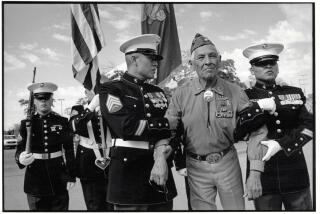Magazine Turns ‘Bridges’ Camera Lens Inward : Reality check: August issue of National Geographic highlights the experiences of the men and women behind the cameras. ‘Madison County’ is fiction; truth is both more adventurous and prosaic.
- Share via
WASHINGTON — “I live with dust in my heart,” lovelorn National Geographic photographer Robert Kincaid laments in “The Bridges of Madison County.”
The magazine’s real photographers tend to live with mere dust: in the skin, on the lens, kicked up from a sweltering assignment far from the Iowa farmhouse where Meryl Streep waits with brandy and Wind Song perfume.
It seems there aren’t many days when the people who shoot for National Geographic wake up feeling like “the highway and a peregrine and all the sails that ever went to sea,” as Kincaid felt about himself.
Reality can be at once more adventurous and prosaic than the fiction of Robert James Waller’s best-selling 171-page book, and the movie made from it starring Streep and Clint Eastwood.
To bring that into focus, National Geographic turns its lens on itself in its August issue, highlighting the experiences of the men and women behind the cameras.
The article, called “Reel to Real,” says hundreds of people have written to ask when the magazine featured Madison County’s genuine covered bridges. It never has.
In the tale, Kincaid scraped his arm while shooting a bridge from a tree.
In life, Bill Curtsinger was mauled by a great white shark, George Mobley was bitten by a penguin and Joel Sartore was beaten by an Oregon lumberjack who thought an earlier article on forests was “nothing but lies.”
“I kept thinking that this hurt far less than the back pain I’d had the week before on a runaway horse during a cattle drive in Idaho,” Sartore said.
The farm wife Francesca Johnson was a gleam in Kincaid’s eye when he stopped to ask her for directions, beginning a four-day affair that obsessed them for the rest of their make-believe lives.
All George Steinmetz got in his eye was a loa loa worm that almost cost him his sight while on assignment in central Africa.
Dingy motels, divorce and bureaucrats are among the less dramatic hazards of the road. Bruce Dale says that when he came to the magazine in 1964, eight of 12 staff photographers had been divorced, often a consequence of the nomadic life.
“In the field, photographers live totally in the present,” said photography director Tom Kennedy. “They push every other aspect of their lives into their background. It’s liberating. And dangerous.”
To be sure, romance has blossomed. Four National Geographic photographers met their wives--five of them--on assignment.
It’s doubtful any of those women sized up the men as Francesca did with Kincaid: “a leopard-like creature who rode in on the tail of a comet.”
Pack mules might be more like it. While Kincaid traveled in a pickup truck with 200 rolls of film, three cameras and accessories, Emory Kristof went to Lake Baikal in Siberia with a satellite dish, color lab, rubber boat, diesel generator and two remote vehicles in his 15 tons of equipment.
The magazine says it published six of his pictures.
More to Read
Sign up for The Wild
We’ll help you find the best places to hike, bike and run, as well as the perfect silent spots for meditation and yoga.
You may occasionally receive promotional content from the Los Angeles Times.






